The AMD Ryzen 7 5700G, Ryzen 5 5600G, and Ryzen 3 5300G Review
by Dr. Ian Cutress on August 4, 2021 1:45 PM ESTMicrobenchmarks
Core-to-Core Latency
As the core count of modern CPUs is growing, we are reaching a time when the time to access each core from a different core is no longer a constant. Even before the advent of heterogeneous SoC designs, processors built on large rings or meshes can have different latencies to access the nearest core compared to the furthest core. This rings true, especially in multi-socket server environments.
But modern CPUs, even desktop and consumer CPUs, can have variable access latency to get to another core. For example, in the first-generation Threadripper CPUs, we had four chips on the package, each with 8 threads, and each with a different core-to-core latency depending on if it was on-die or off-die. This gets more complex with products like Lakefield, which has two different communication buses depending on which core is talking to which.
If you are a regular reader of AnandTech’s CPU reviews, you will recognize our Core-to-Core latency test. It’s a great way to show exactly how groups of cores are laid out on the silicon. This is a custom in-house test built by Andrei, and we know there are competing tests out there, but we feel ours is the most accurate to how quick an access between two cores can happen.
The Ryzen 7 5700G has the quickest thread-to-thread latency, however does offer a single slowest core-to-core latency. But compared to the 4000G series, having a single unified L3 cache reduces to core-to-core latency a good amount. The Ryzen 5 5300G has the slowest intracore latency, but the fastest average core-to-core.
Per-Core Power
One other angle to examine is how much power each core is drawing with respect to the rest of the chip. In this test, we run POV-Ray with a specific thread mask for a minute, and take a power reading 30 seconds into the test. We output the core power values from all cores, and compare them to the reported total package power.
The peak per-core power is shown as 15.2 W when one core is loaded on the Ryzen 7 5700G, and that comes down to ~8.8W when all cores are loaded. Interestingly this processor uses more power when six cores are loaded.
The Ryzen 5 5300G starts at 11.5 W for a single core, but then moves up to 12.3 W when three cores are loaded. It comes back down to 11.5 W when all four cores are loaded, but this ensures a consistent frequency (the 5300G has a 4.2 GHz Base and 4.4 GHz Turbo, explaining the small variation in loading).
Frequency Ramping
Both AMD and Intel over the past few years have introduced features to their processors that speed up the time from when a CPU moves from idle into a high-powered state. The effect of this means that users can get peak performance quicker, but the biggest knock-on effect for this is with battery life in mobile devices, especially if a system can turbo up quick and turbo down quick, ensuring that it stays in the lowest and most efficient power state for as long as possible.
Intel’s technology is called SpeedShift, although SpeedShift was not enabled until Skylake.
One of the issues though with this technology is that sometimes the adjustments in frequency can be so fast, the software cannot detect them. If the frequency is changing on the order of microseconds, but your software is only probing frequency in milliseconds (or seconds), then quick changes will be missed. Not only that, as an observer probing the frequency, you could be affecting the actual turbo performance. When the CPU is changing frequency, it essentially has to pause all compute while it aligns the frequency rate of the whole core.
We wrote an extensive review analysis piece on this, called ‘Reaching for Turbo: Aligning Perception with AMD’s Frequency Metrics’, due to an issue where users were not observing the peak turbo speeds for AMD’s processors.
We got around the issue by making the frequency probing the workload causing the turbo. The software is able to detect frequency adjustments on a microsecond scale, so we can see how well a system can get to those boost frequencies. Our Frequency Ramp tool has already been in use in a number of reviews.
In our test, the Ryzen 5 5600G jumps from 2700 to the turbo frequency in around a millisecond.


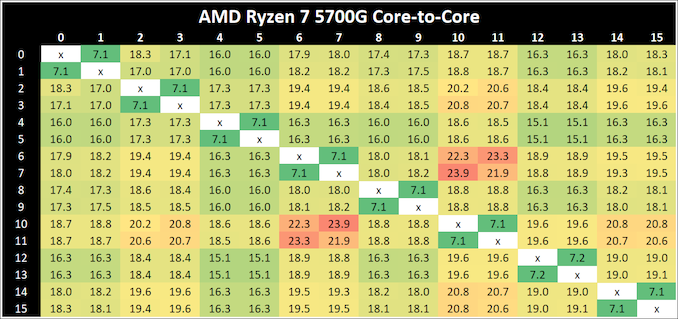
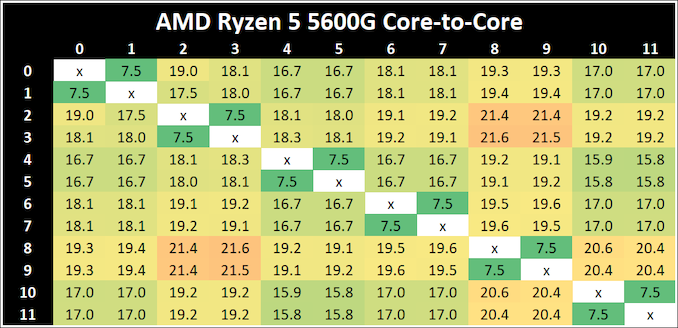
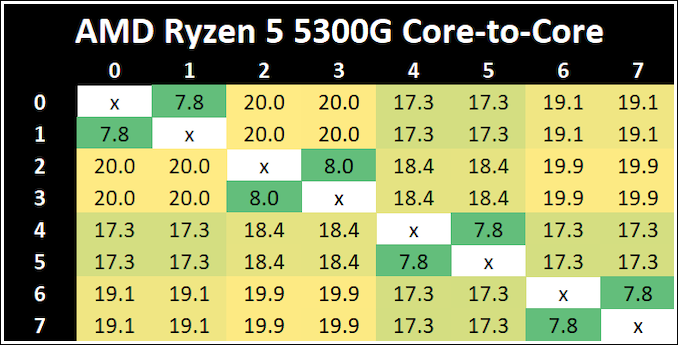
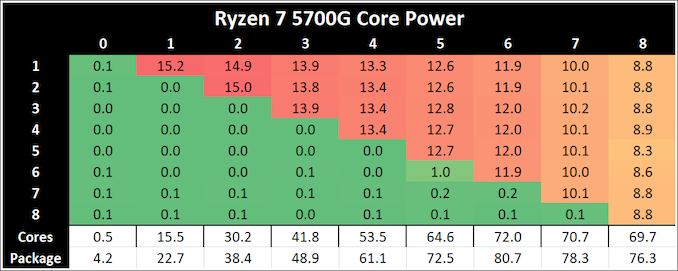

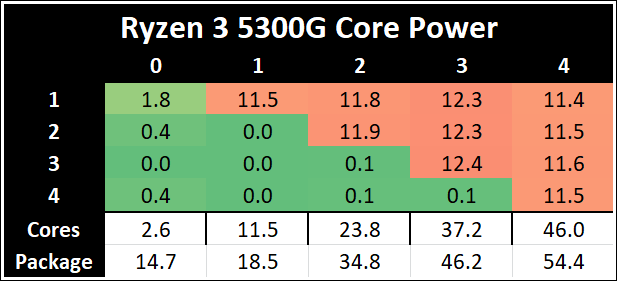
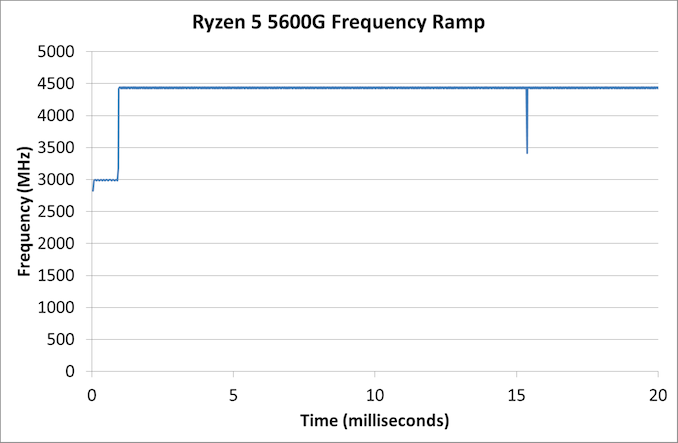








135 Comments
View All Comments
Cooe - Friday, August 6, 2021 - link
The recent GPU driver additions were NOT for Rembrandt. My guess is that's from some as of yet unannounced custom/embedded part for a market/use case where die size is absolutely CRITICAL (the only reason to pick RDNA over RDNA 2 is raw transistor density), that we're seeing there. Rembrandt otoh has had explicitly "RDNA 2" based graphics IP literally since it very first appeared on leaked AMD roadmaps YEARS ago, and it's consistently stayed "RDNA 2" in every future appearance/leaked roadmap.In fact with AMD's penchant for copy-pastaing reusable IP blocks across as many different products as they can, the iGPU implementation on Rembrandt is likely to be EXTREMELY similar to what is currently seen on Van Gogh (in fact, it wouldn't surprise me at ALL if they end up just sharing the exact same 8CU RDNA 2 iGPU block wholesale).
nandnandnand - Saturday, August 7, 2021 - link
https://www.notebookcheck.net/AMD-Ryzen-6000-Rembr..."Van Gogh is said to have eight compute units (CUs) per shader array with a 1 MB L2 cache while Rembrandt will have six CUs per shader array with 2 MB L2 cache, with the added cache possibly translating into improved gaming performance. It must be noted here that we still do not know the total number of CUs on the GPU, but rumors indicate up to 12 CUs for Rembrandt."
AThomas - Wednesday, August 4, 2021 - link
These APU's have my exact use case. Upgrading my HTPC which has trouble with HEVC codec (YouTube 4K) that can easily play PS2, PS1, Dreamcast, Sega 32X/CD, etc, etc. Plus Space Engineers which none of my rigs can play at the moment. All done with the iGPU at 60+FPS or better , also some Xbox titles like Forza Horizon since I don't play on buying a Xbox X.Second use is server. WIth a couple of VM's but mostly containers. Maybe throw a GPU in their for renting out GPU. All those threads will allow lots of functional task to be done.
Jorgp2 - Thursday, August 5, 2021 - link
AMDs APUs don't support GPU virtualizationGreenReaper - Sunday, August 15, 2021 - link
Not yet, no.boozed - Wednesday, August 4, 2021 - link
Are you sure?eastcoast_pete - Thursday, August 5, 2021 - link
Hush now! Ian was spilling Intel's newest acquisition plans..ballsystemlord - Wednesday, August 4, 2021 - link
In addition to what Dan said above your table entitled, "Ryzen 5 APUs (65W)" Is completely wrong. The 5600G is a 6 core processor and I suspect some of the other entries are incorrect also.Rudde - Wednesday, August 4, 2021 - link
"The second part is a Ryzen 5 5600G, featuring six cores and sixteen threads, with a base frequency of 3.9 GHz and a turbo frequency of 4.6 GHz. "This sentence has suffered from some copy and pasting. 12 threads and 4.4 GHz boost.
nandnandnand - Wednesday, August 4, 2021 - link
"However slow quad cores (like the 2400G still let you down."Missing closing parenthesis mark.